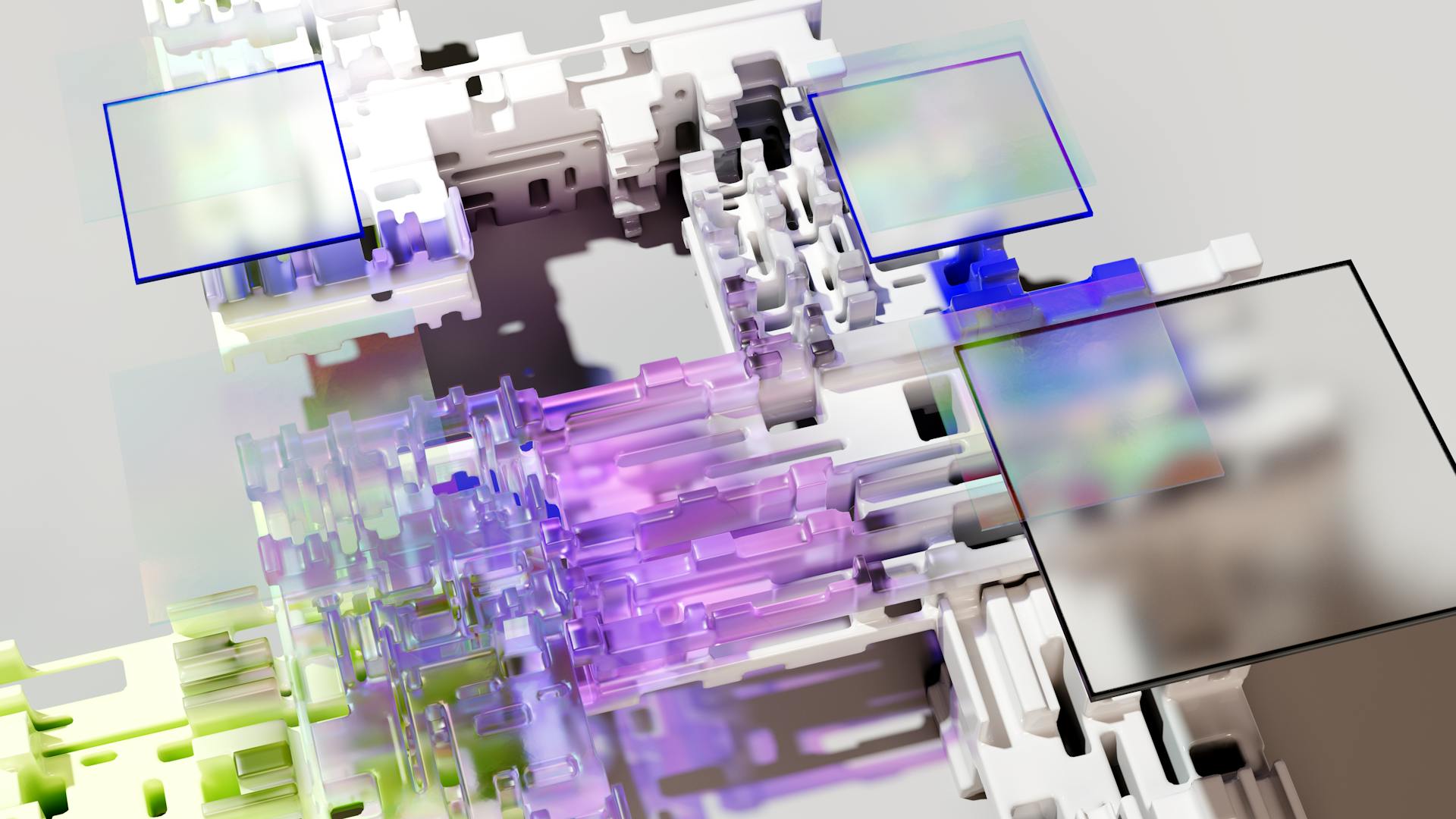
Decision tree pruning is a crucial step in machine learning that helps improve the accuracy and efficiency of decision trees.
Pruning removes branches that don't contribute significantly to the decision-making process, reducing overfitting and improving model interpretability.
By pruning, we can prevent the tree from becoming too complex and reducing its ability to generalize to new data.
This process can be done using various techniques, such as pre-pruning, post-pruning, and cost-complexity pruning.
Pre-pruning involves stopping the tree growth based on a predetermined depth or number of leaves.
Check this out: Decision Tree Algorithm Machine Learning
Decision Tree Basics
A decision tree is a type of machine learning model that uses a tree-like structure to make predictions or classify data.
It starts with a root node that represents the initial input, and each subsequent node represents a decision or classification made based on the input.
Decision trees work by recursively splitting the data into subsets based on the most important features.
The goal is to create a tree that is as simple as possible while still being accurate.
Here's an interesting read: Energy Based Model
Overfitting occurs when the tree is too complex and fits the noise in the training data.
Decision trees can be used for both classification and regression tasks.
The tree is built by recursively selecting the best feature to split the data at each node.
The best feature is the one that results in the most homogeneous subsets.
Decision trees are often used in data science because they are easy to interpret and visualize.
They can handle both categorical and numerical data.
The height of the tree is limited to a maximum depth, which can be a parameter to tune.
The decision tree algorithm is a popular choice for many machine learning tasks.
See what others are reading: Algorithmic Decision Making
Pruning Techniques
There are two ways to prune a decision tree: Post-Pruning and Pre-Pruning.
Post-Pruning involves cutting off branches that are no longer needed from an already completed decision tree, replacing subtrees with nodes when they are deemed unnecessary.
This method is more commonly used and allows for improvements in accuracy and complexity in the pruned tree to be compared with the original tree.
See what others are reading: Ball Tree
Pre-Pruning uses a stopping criterion, such as the depth of the tree, to prevent the tree from further expansion and keep it small from the beginning.
However, Pre-Pruning can lead to premature pruning without considering all the information, resulting in the loss of important information, known as the Horizon Effect.
The direction in which the tree is traversed during Post-Pruning is called either Bottom-Up or Top-Down Pruning.
Bottom-Up starts at the lowest point and then recursively moves upward, while Top-Down Pruning begins at the root and moves downward to the leaves.
For Top-Down Pruning, there is a risk that subtrees may be pruned prematurely, even if relevant nodes are still below.
Here's an interesting read: Top Machine Learning Applications at Fin Tech Companies
Pruning Methods
Decision trees can become too large and complex with Big Data, so pruning is used to exclude unimportant differentiations and keep the tree smaller.
Pruning involves cutting off branches that are no longer relevant and do not worsen the result, ideally improving it.
Consider reading: Alpha Beta Pruning Algorithm
There are two main pruning techniques: Post-Pruning and Pre-Pruning. Post-Pruning is more commonly used and replaces subtrees with nodes when they are deemed unnecessary.
Pre-Pruning uses a stopping criterion, such as the depth of the tree, to prevent further expansion. This process keeps the tree small from the beginning but can lead to premature pruning.
Pruning can be done in a Bottom-Up or Top-Down direction. Bottom-Up starts at the lowest point and moves upward, while Top-Down Pruning begins at the root and moves downward to the leaves.
Pre-pruning can be done by checking if information gain at a node is greater than minimum gain, and post-pruning can be done by pruning subtrees with the least information gain until a desired number of leaves is reached.
Broaden your view: What Is Pretraining and Post Training Ai
Pruning Benefits
Pruning helps prevent Decision Trees from becoming overly large and complex.
By excluding unimportant and redundant differentiations, pruning keeps the tree smaller and more manageable.
Pruning branches that are no longer relevant improves the result, rather than degrading it.
The pruning process typically focuses on branches that satisfy specific criteria, which vary depending on the algorithm used.
Different algorithms allow for adapting the criteria and pruning process to fit specific examples.
Decision Tree Pruning
Decision Tree Pruning is a technique used to prevent Decision Trees from becoming too large and complex, especially with the advent of Big Data. This process involves excluding unimportant and redundant differentiations to keep the tree smaller and more manageable.
Pruning is done by excluding branches that are no longer relevant and do not worsen the result, but ideally, improve it. Typically, only those branches are pruned that satisfy specific criteria.
There are several algorithms used for pruning, including Cost-complexity pruning, Reduced Error Pruning (REP), and Critical Value pruning. Each algorithm has its own criteria for pruning branches.
Cost-complexity pruning calculates a Tree Score based on Residual Sum of Squares (RSS) for the subtree, and a Tree Complexity Penalty that is a function of the number of leaves in the subtree.
Reduced Error Pruning (REP) is a post-pruning method that uses a validation set to evaluate nodes for pruning. A node is pruned if the resulting pruned tree performs no worse than the original tree on the validation set.
For more insights, see: Rademacher Complexity
Instead of continuing to create the tree until it fits perfectly to the given data, some methods stop at any nodes separating it into several nodes when the number of samples within it is smaller than a certain threshold.
The following methods are commonly used for pruning decision trees:
- Critical Value pruning: stops at nodes with a small number of samples
- Error Complexity pruning: uses a validation set to evaluate nodes for pruning
- Reduced Error Pruning (REP): prunes nodes if the resulting pruned tree performs no worse than the original tree on the validation set
It's worth noting that there is no significant interaction between the creation and pruning methods, according to empirical comparisons.
Sources
- https://lamarr-institute.org/blog/decision-trees-pruning/
- https://swagata1506.medium.com/pruning-in-decision-trees-4cfa10a36523
- https://stats.stackexchange.com/questions/475863/pruning-in-decision-trees
- https://link.springer.com/article/10.1023/A:1022604100933
- https://developers.google.com/machine-learning/decision-forests/overfitting-and-pruning
Featured Images: pexels.com


